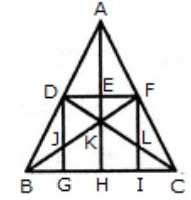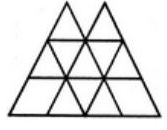Overview: Counting Figures | Reasoning Aptitude for Competitive Examinations - Bank Exams PDF Download
| Table of contents |

|
| Counting of Figures |

|
| An Easier Approach |

|
| Solved Examples |

|
| Practice Questions |

|
Counting of Figures
In the counting of figures, you have a shape or a figure. From the given shape you will have to identify a given known shape and count the number of times it is present in the given shape. For example, consider the following figure:

A typical counting figures question will ask you to find out how many triangles can you identify here? This may seem easy but as you will see it can get very tricky! Let us name the different vertices of the triangle and also give names to every point of intersection inside or on the triangle. This will help us identify and keep track of the number of triangles in the figure.
An Easier Approach

There are some triangles that are easily identifiable. They are triangles (A D E), (A E F), (D E K), (E F K), (D J K), (F L K), (D J B), (F L C), (B J G), and (L I C) as you can see in the figure. The number of these triangles is ten.
There are other triangles composing of two portions or two components. They are triangles (A D F), (A F K), (D F K), (A D K), (D K B), (F C K), (B K H), (K H C), (D G B), and (F I C).
Similarly, we can find the triangles that are made up of three components. They are the triangles (D F J), and (D F L).
Also, the triangles that have four components are (A B K), (A C K), (B F I), (C D G), (D F B), (D F C) and (B K C). Thus they are seven in number. There are no triangles that have five components.
Now we can also find the triangles that are composed of six components. They are the triangles (A B H), (A C H), (A B F), (A C D), (B F C), and (C D B). Thus they are six in number.
At last, we see that there are no triangles with seven, eight, nine, ten or eleven components. And there is only one triangle which has all the twelve components i.e. the triangle A B C. Therefore, the total number of triangles in the above figure is 10 + 10 + 2 + 7 + 6 + 1 = 36.
Solved Examples
Example 1: What is the number of triangles in the following figure?
Ans: The first step should be to label every vertex and point of intersection of lines as shown in the following figure:

Now let us see the triangles that are formed by a single component from the figure. These are the triangles (B F G), (C G H), (E F M), (F M G), (G M N), (G H N), (H N I), (L M K), (M N K), and (K N J). They are ten in number.
Two components when joined won’t make a triangle, therefore there are no such triangles. The triangles that have three components are (F A K) and (H K D). These are two in number.
Also, the triangles with four parts are (B E N), (C M I), (G L J), and (F H K), hence four in number.
Similarly, we see that five, six, and seven components won’t make a triangle. We thus move on to count the number of triangles that are formed from eight components each. They are (B A J), and (O L D). This is the maximum number of components here. Therefore the total number of triangles here is 10+2+4+2 = 18. Thus, the figure that was present above has 18 triangles in it.
Example 2: What is the number of triangles in the following figure?

Ans: The first step as usual is to label every vertex and point of intersection in the given figure as shown below:

Now that we have taken care of the labelling, let us see what we can do with the counting, Here we have small triangular shapes present towards the edges of the large square and in between, we have small squares.
The triangles that are easily spotted are (A M L), (L R K), (K W D), (D W J), (J X I), (I Y C), (C Y H), (H T G), (G O B), (B O F), (F N E) and the triangle (E M A). These are twelve in number.
Now let us count the triangles made from two components. These are the triangles (A E L), (K D J), (H I C) and (F B G). These are four in number.
Also we can count the number of triangles that are made up of three components each. These are (A P F), (E Q B), (B Q H), (G V C), (C V J), (I U D), (D U L) and the (K P A). These are eight in number.
Similalry we see that the triangles (A S B), (B S G), (C S D), (D S A), (A K F), (E B H), (G C J) and (I D L) are made up of six components.
And the triangles (A D B), (A B C), (B C D) and (C D A) are made up of twelve components. Thus the total number of triangles in the figure is 12+4+8+8+4 =36.
Practice Questions
Q1: What is the minimum number of straight line segments used to form the following figure?

(a) 36
(b) 46
(c) 66
(d) 14
(e) 21
Ans: (d) 14
|
73 videos|130 docs|124 tests
|




















